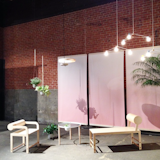Perched below the Griffith Observatory and overlooking Hollywood is a lush lot crowned with four towering olive trees and a 1965 home designed by modernist architect Craig Ellwood. When a young couple purchased the home in 2018, it needed substantial work. For a historic restoration, they called on Woods + Dangaran, a local firm fluent in modernist history. The team completed a meticulous restoration of the home while keeping original components like the linear shape, open plan, and expansive windows. One of the most striking features is the original koi pond (a feature deemed so essential that its preservation was a condition of escrow) that is now crossed via a bridge that leads to a new lap pool—perhaps the biggest intervention on the property.
In 1977, favorite California's midcentury modern pioneers Charles and Ray Eames exhibited a selection of their bent plywood pieces at Washington University, including the leg splints they produced as part of the war effort in 1942, shown here hanging on the wall. Charles also studied architecture at Washington University, briefly, on scholarship for two years.
Credit: Charles Eames Archive, University Archives, Department of Special Collections, Washington University Libraries
The Eames house living room as it is best known, shot in 1994. The light from the window illuminates the tumbleweed the couple picked up on their honeymoon drive from Chicago to Los Angeles; due to its fragility it was the only item not to have been moved to the LACMA exhibition. Photo courtesy Tim Street-Porter.
Swiss architect Peter Zumthor— himself considered a bit of a enigma in a world that lauds celebrity designers—built the tiny Bruder Klaus Field Chapel in western Germany in 2007. The structure was created by arranging 112 spruce trees, pouring concrete on top until it set, then burning the wood, leaving a charred interior cavity.
Built between 1947 and 1950, the Shulman house was the result of a collaboration between the photographer and architect Raphael Soriano, and served as Shulman’s home for more than half his life. Perched on a hill in Laurel Canyon on Woodrow Wilson Drive, the house was designated a Los Angeles Cultural Heritage monument in 1987. The one-story, exposed-steel-frame structure is defined by its central “spine” and surrounded by gardens that Shulman left in a somewhat wild state.
When Dwell visited Shulman two years before his death, he was satisfied with the career he had built, and still actively giving lectures, photographing houses, and talking to journalists. "I'm always identified as being the best architectural photographer in the world," Shulman declared. "I disclaim that. I say, 'One of the best."
Having fallen into great disrepair and almost subjected to the wrecking ball until Shulman’s original photographs were found on the property and used for a historically accurate renovation, Carl Louis Maston’s 1962 Hillside House still survives. The home is surrounded by earth and set into a 45-degree slope. The sundeck above the driveway shields the master bedroom from the street. © J. Paul Getty Trust. Used with permission. Julius Shulman Photography Archive, Research Library at the Getty Research Institute (2004.R.10)
Multiple skylights, including one over the kitchen, bring sunshine into the home while keeping it private from surrounding neighbors. Pendant lights by Arne Jacobsen for Louis Poulsen, hanging over a dining table by ercol furniture, provides additional illumination. “The kitchen-dining-living room is cozy, but it is large enough to entertain 12 people,” Thomson says. The green chair is a prototype from Barber Osgerby and the rug is by Kate Blee.
Wrk-Shp
“Part of our ethos is that we are not fashion designers. We aren’t furniture designers. We aren’t architects. We are designers, and we can apply our vision to any medium and put our spin on it,” says Wrk-Shp co-founder Airi Isoda. Demonstrating that flexibility, this simple concrete planter can lie flush against the wall, hang independently, or be dropped into a table.
1 more save



































